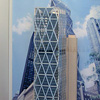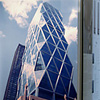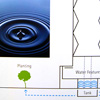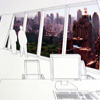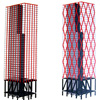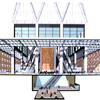The Skyscraper Museum is devoted to the study of high-rise building, past, present, and future. The Museum explores tall buildings as objects of design, products of technology, sites of construction, investments in real estate, and places of work and residence. This site will look better in a browser that supports web standards, but it is accessible to any browser or Internet device.
The Hearst Tower
The Hearst Tower and The New York Times Building represent conscious experiments in new high rise paradigms for New York, both in terms of formal and structural expression and in the aesthetics of the work place. The media companies selected the renown European architects Norman Foster and Renzo Piano, designers who are also known for their pioneering commitment to green building philosophy and technology.
Foster's Commerzbank tower in Frankfurt, which was Europe's first green skyscraper in 1995, innovated the interior of the high rise by organizing office floors and communal spaces called "sky gardens" around an open central court that cooled and ventilated the space. A similar layout is a key feature of Foster and Partners' recent ovoid-shaped skyscraper in London, 30 St. Mary's Axe, nicknamed ‘the Gherkin." Creating an astonishing form that breaks with norms, but develops from a logic established by the concept of reforming the work place, is a modus operandi of Foster. The strategy shapes the Hearst Tower's diagrid structure of triangles and diamonds, as well as the interior planning, where large unobstructed office floors afford access to natural light and views for most workers and communal and public spaces occupy the most prestigious and monumental of the buildings's spaces, the atrium lobby and the top of the tower.
The Hearst Tower and The New York Times Building represent conscious experiments in new high rise paradigms for New York, both in terms of formal and structural expression and in the aesthetics of the work place. The media companies selected the renown European architects Norman Foster and Renzo Piano, designers who are also known for their pioneering commitment to green building philosophy and technology.
Foster's Commerzbank tower in Frankfurt, which was Europe's first green skyscraper in 1995, innovated the interior of the high rise by organizing office floors and communal spaces called "sky gardens" around an open central court that cooled and ventilated the space. A similar layout is a key feature of Foster and Partners' recent ovoid-shaped skyscraper in London, 30 St. Mary's Axe, nicknamed ‘the Gherkin." Creating an astonishing form that breaks with norms, but develops from a logic established by the concept of reforming the work place, is a modus operandi of Foster. The strategy shapes the Hearst Tower's diagrid structure of triangles and diamonds, as well as the interior planning, where large unobstructed office floors afford access to natural light and views for most workers and communal and public spaces occupy the most prestigious and monumental of the buildings's spaces, the atrium lobby and the top of the tower.

